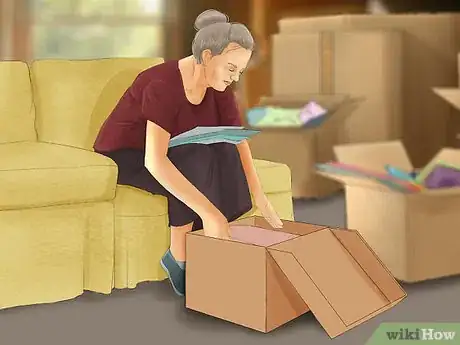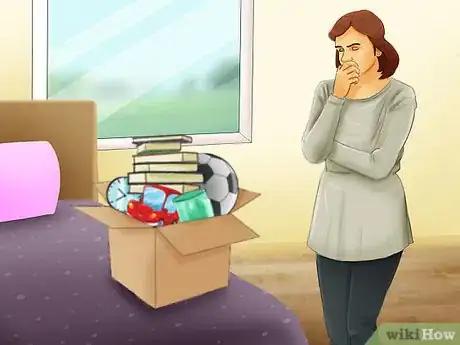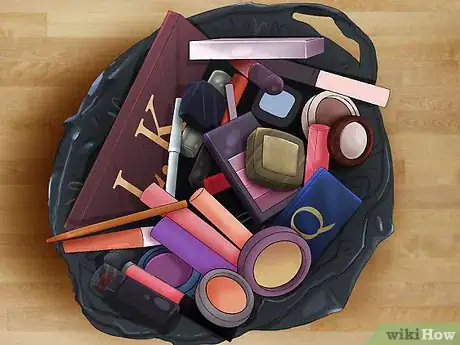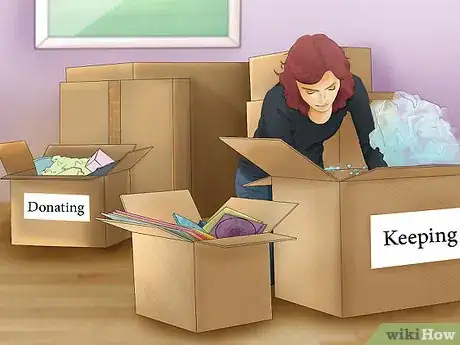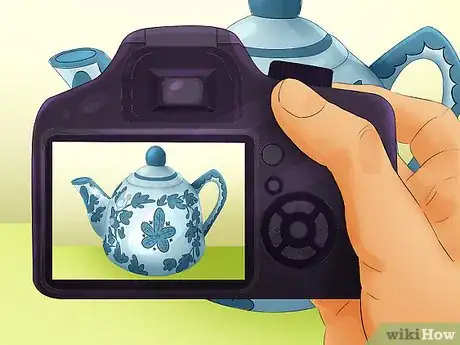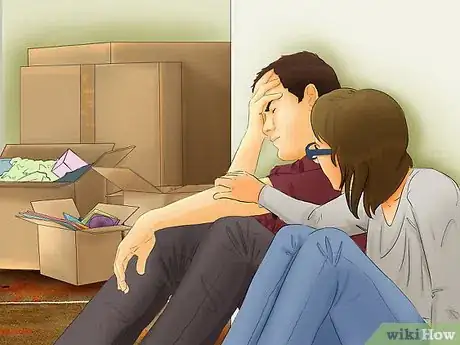This article was co-authored by John A. Lundin, PsyD. John Lundin, Psy. D. is a clinical psychologist with 20 years experience treating mental health issues. Dr. Lundin specializes in treating anxiety and mood issues in people of all ages. He received his Doctorate in Clinical Psychology from the Wright Institute, and he practices in San Francisco and Oakland in California's Bay Area.
This article has been viewed 32,888 times.
There’s almost nothing that is more heartbreaking than losing a loved one. Second to this is going through that person’s belongings. This is often a heart-wrenching experience because you are sorting through pieces that the person lived with, and you probably have memories with many of these items. Although it may be difficult, you can get through it by preparing yourself mentally, sorting through the items with a purpose, and being easy on yourself.
Steps
Figuring Out Your Process
-
1Plan your attack. Start your process by deciding if you are on a time crunch or if you can go slow. If you’re on a deadline, set milestones throughout the process to keep yourself on track. If you aren’t in any rush, take the process one step at a time. Don’t put too much stress on yourself, but don’t avoid the task, either.
- Deciding to go through the home room by room is one good way to start the process. Or you could decide to go through the belongings based on items, such as books, textiles, chotskies, etc. Going in without a plan can be overwhelming and can lead to more stress and heartache that you simply don’t need right now.[1]
- Include your family members in this process. They may want to take some things for themselves. They may even be willing to help you sort through the items.
-
2Understand that you can’t keep everything. As much as you want to hold onto every item that reminds you of the departed, doing so is impractical. Not only do you likely not have room in your own home to house the items of another, but not everything should necessarily be kept. Old newspapers, raggedy towels, and items that have seen much better days are those you may consider getting rid of.
- Remind yourself that letting go of items isn’t disrespectful to your loved one. Material items are not what defined your relationship, it was the memories you had together.[2]
EXPERT TIPJohn Lundin, Psy. D. is a clinical psychologist with 20 years experience treating mental health issues. Dr. Lundin specializes in treating anxiety and mood issues in people of all ages. He received his Doctorate in Clinical Psychology from the Wright Institute, and he practices in San Francisco and Oakland in California's Bay Area.Clinical Psychologist
 John A. Lundin, PsyD
John A. Lundin, PsyD
Clinical PsychologistOur Expert Agrees: Try to remember that your loved one and their things are not the same. You can let go of their things without letting go of your memories of them.
Advertisement -
3Decide how much you are able to keep beforehand. Take an evaluation of your own home and decide how much room you have for your loved one’s belongings before you begin sorting through their home.
- Keeping more than you have room for could result in you needing a storage unit to have a place for everything, which defeats the purpose of keeping the items, as you won’t be able to see them. Be honest with yourself and then stick to what you decided.[3]
- For example, maybe your mom left behind a large china collection that you really do not have space to store or display. You might pass some along to your siblings for their homes or donate to Goodwill.
Sorting Through the Items
-
1Start with the trash. Throw away any items you know you aren’t keeping, particularly items that will mold or go bad. Toiletries and pantry products are usually ones to eliminate, as are items that are in bad condition. Unless you aren’t keeping these items, they should go in the trash as they probably aren’t suitable for anything else.[4]
- To ensure you are ready to tackle this project, equip yourself with an adequate amount of trash bags and boxes. You may also recycle some items rather than throwing them away. If you have a huge amount of items to be trashed, consider renting a trash bin from your local trash collector to help with the process.
-
2Make piles. After you throw away what you can’t keep, create two piles: what you are keeping and what you are donating. As the names imply, you will hold onto the items in the keep pile for yourself or for others, and donate or sell the items in the other pile. Once you make these definitive piles, do something with them; don’t allow them to stay in the space for too long because they will just create more clutter.
- Make piles as you go through each room or sort through each item, do what you’re going to with the piles, and then tackle the rest. Don’t allow the piles to sit. [5]
-
3Select items that fit into your life and have meaning for you. Even though your loved one would probably love it if you could take all their possession, it's doubtful that they'd want you to become a hoarder. Be selective with what you decide to keep for yourself.
- For example, if your mom had some lovely paisley bed linens that match your guest bedroom, you might honor her by using them in that room.
- If your dad had a vintage car that was his pride and joy, you might choose to keep it and use it for weekend outings or special occasions.
-
4Ask another person for an objective opinion. If you're having difficulty deciding what to keep and what to give away, ask a friend or family member for their opinion. They may be able to offer a more objective, rational view.
- For example, if you're torn over keeping your father's entire watch collection, a friend can help you choose one to keep while giving away the rest.
-
5Take pictures of what you can’t keep. You may love some items dearly, but they just don’t make sense to keep. Snap photographs of these pieces. Doing so allows you to hang onto them in some way, but without taking up room in your home.[6]
- Just having the memory of these sentimental items might give you some peace of mind. Therefore, snap a photo of your dear aunt's beautiful porcelain cat collection before you donate or sell it. That way, you can always look back and remember it how it was.
Being Easy on Yourself
-
1Talk to others and ask for help. Letting go of sentimental items is difficult, and you’re going through one of the worst times in your life right now. If doing this project alone is too much for you, ask for help. Not only will this take some of the pressure off of you, but having someone work alongside of you may also keep you motivated and on track.[7]
- Simply say to a sibling or partner, “I want to go through Dad’s things today, but I need some emotional support. Will you help me?”
-
2Avoid regrets. It’s easy and common to second guess yourself when deciding what to keep and what to get rid of. However, you’ll need to eliminate any regrets you may feel after. Beating yourself up for not keeping every item is pointless, and a feeling that you don’t need right now.[8]
- Try to process your emotions and grief as much as you can before you start this process. When you're feeling emotional it's hard to make rational decisions.
- Take as much time as you need to grieve before you begin. This will prevent you from keeping items you can't store or throwing away items you later wished you had kept.
- If you find yourself becoming emotional while sorting, take a break, and start again later when you're calm.
-
3Take breaks. Rome wasn’t built in one day, and you won’t get through your loved one’s belongings in that amount of time, either. You’ll likely find moments that you’ll feel emotional and overwhelmed.
- When this occurs, take a break, whether it’s for a few hours or a few days. Come back when you’re in a better state and you’ll likely find yourself more productive.[9]
References
- ↑ http://www.whatsyourgrief.com/sorting-through-belongings/
- ↑ http://www.refinery29.com/lost-loved-one-possessions-guide
- ↑ http://www.huffingtonpost.com/gloria-horsley/cleaning-out-a-deceased-l_b_6065480.html
- ↑ https://unclutterer.com/2012/06/04/uncluttering-after-the-loss-of-a-loved-one/
- ↑ http://www.whatsyourgrief.com/sorting-through-belongings/
- ↑ http://www.huffingtonpost.com/gloria-horsley/cleaning-out-a-deceased-l_b_6065480.html
- ↑ https://unclutterer.com/2012/06/04/uncluttering-after-the-loss-of-a-loved-one/
- ↑ http://www.refinery29.com/lost-loved-one-possessions-guide
- ↑ http://www.whatsyourgrief.com/sorting-through-belongings/

